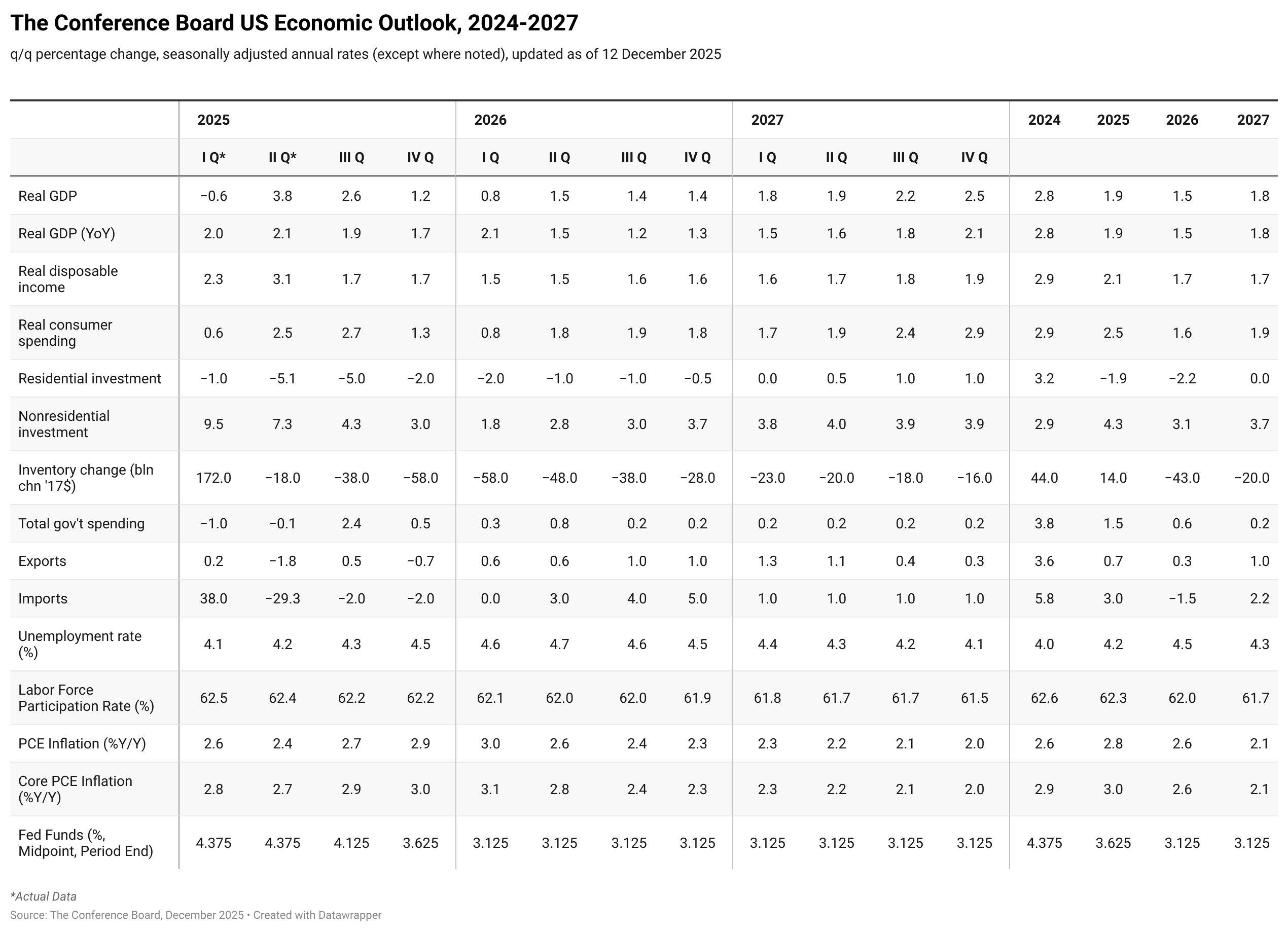
The US economy is heading into 2026 with heightened uncertainty due to the effects of evolving policy decisions. We maintain our expectation of slower growth through late 2025 and early 2026 because of tariffs, even though we slightly upgraded growth in H2 2025. Fiscal policy will deliver mixed effects next year: growth support from accelerated depreciation and tax cuts will be partially offset by reduced green investment and cuts to Medicaid and Supplemental Nutrition Assistance Program (SNAP). The monetary policy outlook will depend heavily on the composition of the Fed under a new chairperson. The mid-term elections at the end of the year could prompt some federal government stimulus to address “affordability” concerns, creating upside risks to growth. Meanwhile, widespread hiring freezes and recent announced layoffs create downside risks to the current low-churn equilibrium in the labor market. The Conference Board still expects real GDP growth to weaken amid a fragile balance of resilient labor markets and softening consumer demand due to tariff-induced inflation. PCE inflation is projected to peak slightly above 3% y/y in H1 2026 before easing to 2.3% by year-end, with unemployment rising toward 4.7% in early 2026.2026: A Year Defined by Policy Crosswinds

The Fed delivered another 25bp rate cut at the December 9–10, 2025 meeting, bringing the target range to 3.50–3.75%. Chair Powell emphasized that policy is now “within the range of plausible neutral estimates,” and the meeting revealed a materially more divided Committee.
Further cuts would require noticeable weakening in the labor market, in our view. October and November federal government data may prove to be inconclusive, because collection was affected by the government shutdown. The Fed may need to see December data, released in the beginning of 2026, to decide whether to pause or cut in January.
Our baseline remains that the Fed will cut two more times in H1 2026 as past tariff actions weigh on the economy and unemployment edges higher. Depending on the 2026 FOMC composition, additional easing in H2 is possib

myTCB® Members get exclusive access to webcasts, publications, data and analysis, plus discounts to events.

Charts
The Gray Swans Tool helps C-suite executives better navigate today’s quickly developing economic, political, and technological environments.
LEARN MORECharts
Preliminary PMI indices show no change in weak DM growth momentum in November
LEARN MORE
Charts
How Might the World Fall Back into Recession?
LEARN MORECharts
Passing increases downstream, cutting costs, and absorbing price increases into profit margins are the chief ways to manage rising input costs. Few see changing
LEARN MORECharts
US continues to lead global productivity race
LEARN MORECharts
The Global Economic Fallout of the Ukraine Invasion
LEARN MORECharts
The global supply chain disruption associated with the COVID-19 pandemic has resulted in production delays, shortages, and a spike in inflation in world.
LEARN MORECharts
The Conference Board recently released its updated 2022 Global Economic Outlook.
LEARN MORE



PRESS RELEASE
US Consumer Confidence Fell Again in December
December 23, 2025
PRESS RELEASE
LEI for China Declined in November
December 22, 2025
PRESS RELEASE
LEI for India Increased in November
December 19, 2025
PRESS RELEASE
LEI for Mexico Ticked Down in November
December 17, 2025
PRESS RELEASE
LEI for the Global Economy Decreased in September
December 16, 2025
PRESS RELEASE
LEI for the Euro Area Declined in November
December 16, 2025
All release times displayed are Eastern Time
Note: Due to the US federal government shutdown, all further releases for The Conference Board Employment Trends Index™ (ETI), The Conference Board-Lightcast Help Wanted OnLine® Index (HWOL Index), The Conference Board Leading Economic Index® of the US (US LEI) and The Conference Board Global Leading Economic Index® (Global LEI) data may be delayed.
This report identifies trends to help businesses prepare for an environment with more challenges for labor and capital but improvements in productivity growth.
LEARN MOREConnect and be informed about this topic through webcasts, virtual events and conferences

Robust Q3 GDP: Finding a Signal in the Noise
December 23, 2025 | Brief
The Conference Board Economic Forecast for the US Economy
December 12, 2025 | Article

Economy Watch: US View (December 2025)
December 12, 2025 | Article

Global Economic Outlook 2026: Euro Area Edition
December 12, 2025 | Report
The Conference Board Economic Forecast for the Euro Area Economy
December 11, 2025 | Article

The Big Picture: What's Ahead for the Global Economy?
December 10, 2025

Economy Watch: Trends in Consumer & CEO Confidence
November 12, 2025

US Tariffs: What’s Changed, What’s Next
October 15, 2025

The Economic Outlook—Storms or Sunshine Ahead?
September 10, 2025

Economy Watch: US Public Policy and the Economy
April 09, 2025

US Economic Volatility in 2025
February 12, 2025
